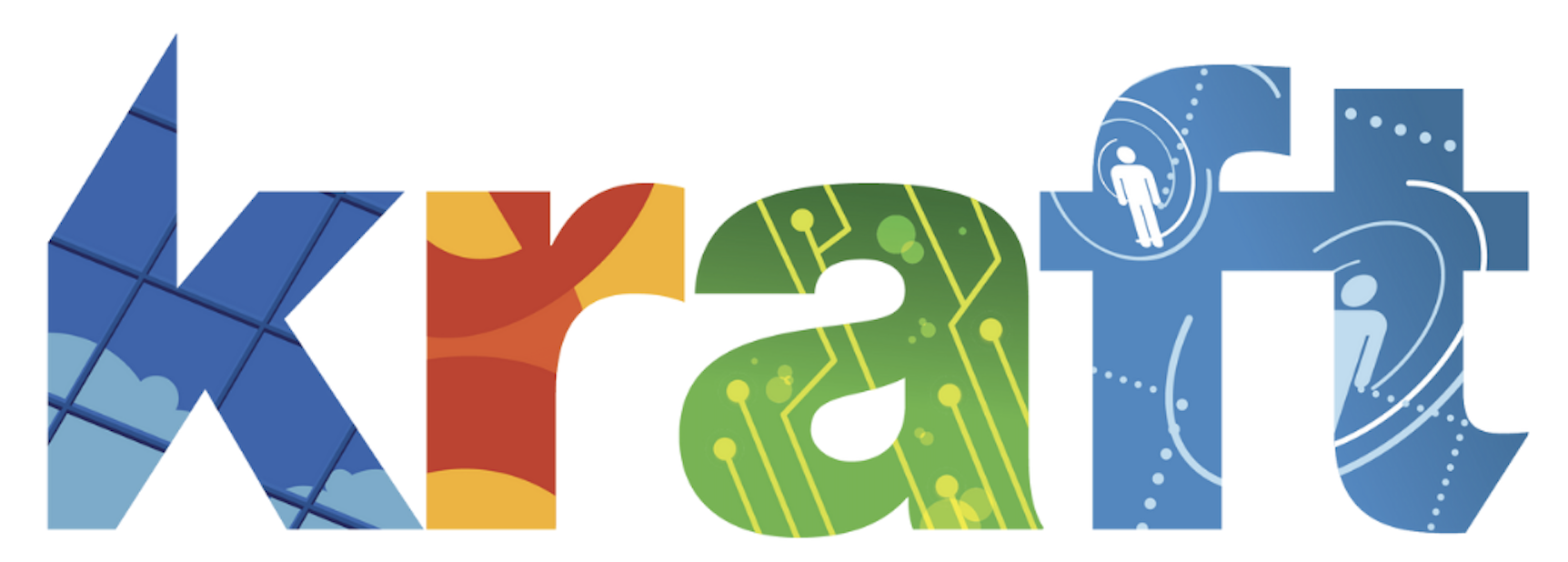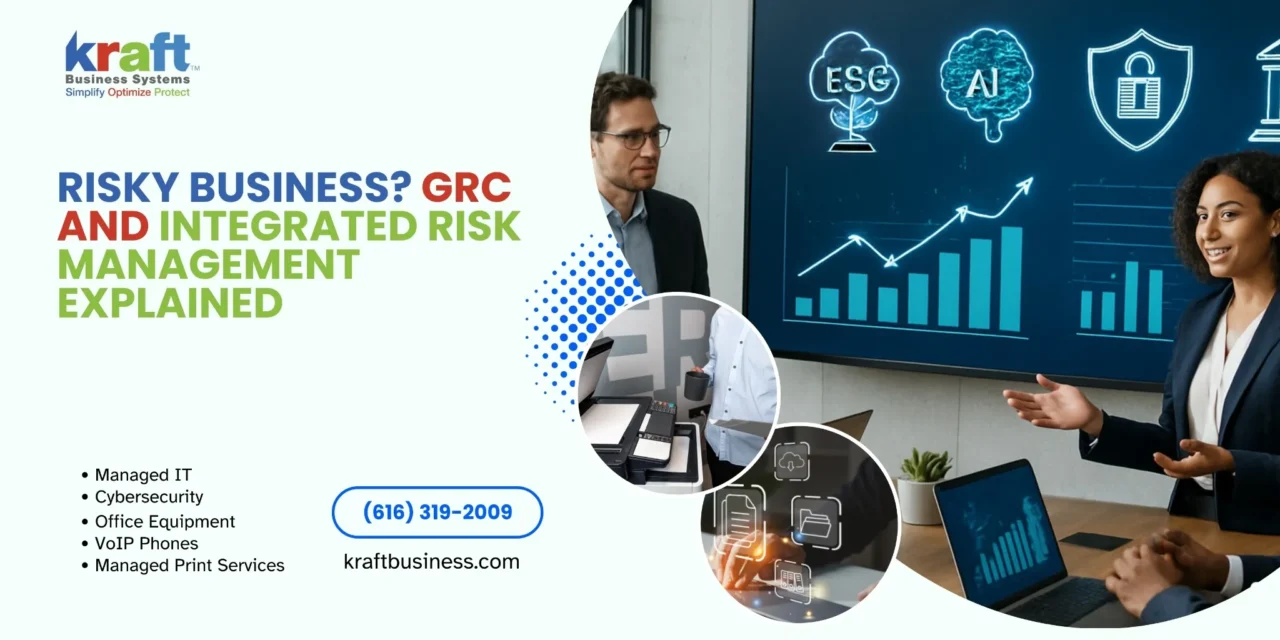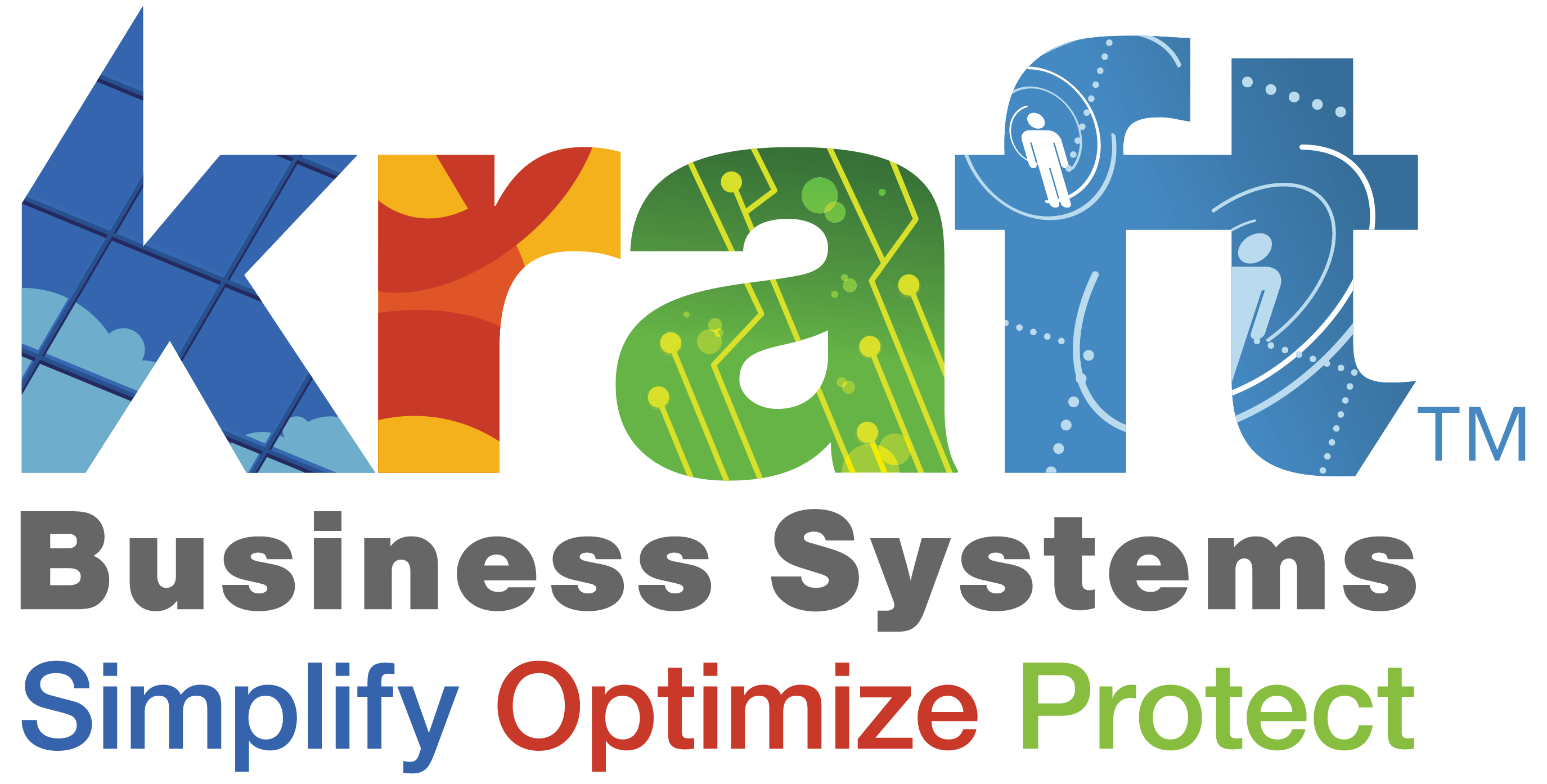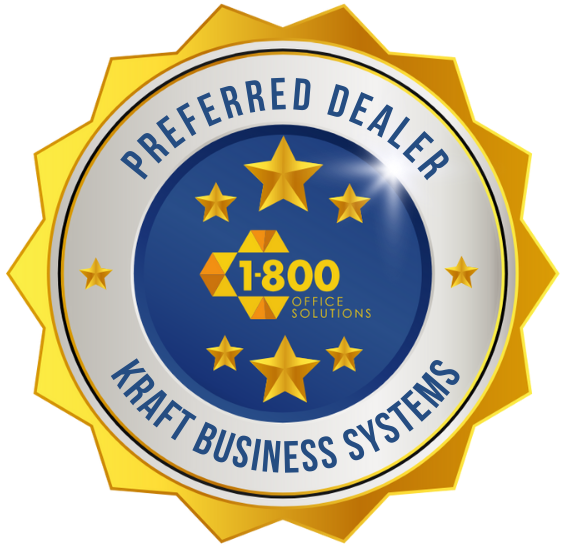Let’s get straight to the heart of what matters for your business. GRC integrated risk management brings together two powerful frameworks that can help your organization steer uncertainty while staying on track toward your goals. If you’ve been wondering how these approaches differ, here’s a simple comparison:
| Framework | Primary Focus | Approach | Best For |
|---|---|---|---|
| GRC (Governance, Risk, Compliance) | Regulatory compliance and controls | Top-down, structured | Organizations with heavy compliance needs |
| IRM (Integrated Risk Management) | Enterprise-wide risk assessment | Cross-functional, collaborative | Organizations needing dynamic risk visibility |
GRC came into prominence in the early 2000s when businesses were scrambling to meet new regulations like Sarbanes-Oxley. Meanwhile, IRM evolved around 2018 as a more comprehensive approach that weaves risk management into the fabric of every department.
For Michigan business owners like you, understanding these frameworks isn’t just academic theory—it’s essential protection. With cyber threats multiplying faster than mushrooms after a spring rain and regulations tightening every year, taking a fragmented approach to risk management is like leaving your back door open uped while installing an alarm at the front.
As GRC expert Michael Rasmussen puts it: “While every organization does GRC, their approaches and results vary.” The difference between checking compliance boxes and embracing true integrated risk management could determine whether your business merely survives or genuinely thrives when challenges arise.
Companies that implement integrated solutions report reducing compliance costs by over 30% while saving hundreds of hours each year on testing and documentation. Forward-thinking businesses are building risk-aware cultures that transform risk management from a necessary evil into a genuine competitive advantage.
Quick look at grc integrated risk management:
Why Compare GRC and IRM?
The comparison between these frameworks reflects real pressures facing businesses across Grand Rapids, throughout Michigan, and beyond.
Historically, organizations treated governance, risk, and compliance as separate functions operating in their own silos. Remember the accounting scandals with Enron and WorldCom? These corporate disasters triggered a wave of regulations, most notably the Sarbanes-Oxley Act of 2002. Suddenly, businesses faced intense compliance pressure and needed structured approaches to manage the complexity.
Fast forward to our current reality, and digital change has multiplied risk vectors exponentially. From sophisticated ransomware attacks to hidden vulnerabilities in your third-party vendors, the risk landscape has become dramatically more complex and dangerous.
A recent industry survey revealed something concerning: 65% of organizations feel their investment in risk management tools is falling behind current threats, while another 65% admitted they weren’t even familiar with what GRC actually means. This knowledge gap creates dangerous blind spots that could leave your business vulnerable precisely when protection matters most.
Governance, Risk Management, and Compliance (GRC) 101
At its heart, grc integrated risk management begins with understanding what GRC actually means. The Open Compliance and Ethics Group (OCEG) defines GRC as “the integrated collection of capabilities that enable an organization to reliably achieve objectives, address uncertainty, and act with integrity.”
Think of GRC as a three-legged stool, with each leg essential for stability:
Governance serves as your organization’s guiding hand – it’s the leadership structures and processes that steer your company forward. Just like a musical score guides an orchestra, governance provides direction for your business performance.
Risk Management acts as your business radar system, constantly scanning for potential problems. It involves identifying, assessing, and handling risks before they become crises. Like a good chess player, effective risk management helps you think several moves ahead.
Compliance ensures you’re playing by the rules – both the ones society sets (laws and regulations) and the ones you set for yourself (internal policies). It’s not just about avoiding penalties; it’s about building trust with customers and partners.
The OCEG GRC Capability Model introduces the concept of “Principled Performance” – a fancy way of saying you can achieve your goals while managing uncertainty and maintaining integrity. As your GRC approach matures, you move from putting out fires to preventing them in the first place.
Governance, Risk, and Compliance Framework: Building a Strong Foundation
Core Components & Evolution
GRC wasn’t born yesterday. The formal concept emerged around 2002, right when the Sarbanes-Oxley Act arrived following some major corporate scandals. Initially, most organizations approached GRC like separate islands – the governance team rarely talked to the risk team, who barely acknowledged the compliance folks.
This disconnected approach created real headaches:
- Teams duplicated each other’s work
- Risk assessments varied wildly across departments
- Leadership received fragmented, often contradictory reports
- Compliance gaps appeared at the seams between departments
- Resources went to waste
As these problems became painfully obvious, businesses started connecting the dots. GRC evolved from a purely compliance-focused approach (“let’s not get fined”) to risk-aware (“let’s anticipate problems”) to performance-driven (“let’s use risk management as a competitive advantage”).
ISO 31000 defines risk as “the effect of uncertainty on objectives.” This highlights why strategic alignment matters so much in GRC – you can only manage risk effectively when you understand what your organization is trying to achieve.
The numbers tell a sobering story: typical organizations today maintain over 200 key internal controls for each type of compliance, with each control requiring more than 40 hours to test. Without an integrated approach, this burden crushes productivity and innovation.
What Is Integrated Risk Management (IRM)?
Think of Integrated Risk Management (IRM) as GRC’s forward-thinking cousin. It emerged naturally as organizations realized risk management needed to be woven into the fabric of everyday business operations—not just treated as a compliance checkbox.
In 2018, Gartner put IRM on the map as a distinct approach that places risk at the center of decision-making. While they’ve since stepped back from treating it as a separate market category, the core principles of IRM remain incredibly valuable for businesses facing today’s complex threat landscape.
IRM brings six powerful elements to the table:
- Strategy: Building a genuinely risk-aware culture where everyone understands their role
- Assessment: Identifying and prioritizing risks that could impact your business objectives
- Response: Taking smart, coordinated action to address those risks
- Communication: Making sure everyone who needs to know about risks has clear information
- Monitoring: Keeping a watchful eye on both known risks and emerging threats
- Technology: Using the right tools to make all of this work efficiently
What makes IRM special is how deeply it embeds risk thinking throughout your organization. Rather than treating risk as something only the compliance team worries about, IRM makes it everyone’s business—from frontline employees to the CEO.
GRC Risk Management: Strategies for Success
IRM Principles in Action
When IRM principles truly take root, they transform how your entire organization thinks about risk. Here’s a simple example:
A suspicious email lands in an employee’s inbox. In a company that just “does compliance,” that employee might flag it because they had to sit through security training last quarter. But in an IRM-driven organization, that same employee understands how this threat connects to broader business goals, feels personal ownership of the risk, and knows exactly how their response helps protect the entire company.
The magic of IRM happens through:
Risk-Aware Culture where every team member sees themselves as part of your risk defense system. From the receptionist to the CEO, everyone understands how their actions impact organizational risk.
Cross-Departmental Collaboration that breaks down traditional silos. Your finance team shares risk insights with IT, who collaborates with operations, who partners with legal—creating a powerful web of risk awareness.
Performance Connection that ties risk management directly to business outcomes. Risk isn’t managed just to avoid bad things; it’s managed to help achieve great things.
As industry expert Bob Morrell puts it: “For a time we used the term enterprise-wide risk management, but a more accurate term is enterprise-deep. But that just sounds odd.”
That’s the essence of IRM—it’s not just about spreading risk awareness across departments, but embedding it deeply from the front desk to the boardroom. It’s about making risk management part of your company’s DNA.
GRC vs. IRM: Key Similarities and Differences
When comparing GRC integrated risk management approaches, it helps to think of them as cousins in the same family – related but with distinct personalities and strengths.
Both frameworks share important DNA. They both aim to align risk management with what your business is trying to achieve. They create structure around uncertainty (which businesses have plenty of!). Both improve your decision-making by providing better information and breaking down those troublesome data silos that keep departments from talking to each other. And yes, they both help you stay on the right side of regulations.
But their approaches reflect different philosophies about managing risk:
| Aspect | GRC | IRM |
|---|---|---|
| Primary Focus | Compliance and controls | Risk and business outcomes |
| Architecture | Top-down, policy-driven | Collaborative, risk-driven |
| Technology | Often separate tools for each function | Integrated platforms with shared data |
| Ownership | Primarily compliance, audit, and risk teams | Distributed across all business units |
| Reporting | Periodic, often retrospective | Continuous, often predictive |
| Culture | Rule-following emphasis | Risk-awareness emphasis |
GRC Integrated Risk Management Side-by-Side
Think of traditional GRC as starting with rules and regulations, then working backward. It’s compliance-centric – focused on meeting requirements and implementing controls to satisfy auditors and regulators. GRC typically flows from the top down, with leadership establishing policies that everyone else follows.
IRM, on the other hand, starts with risks and works forward. It’s risk-centric, focusing first on identifying what could impact your business goals, then figuring out how to manage those risks effectively. IRM spreads responsibility across teams and departments, creating a more collaborative approach.
As one risk management expert colorfully puts it: “GRC programs operate as closed, isolated systems, while IRM strategies are open and integrated across the organization.”
You can spot the difference in how each approach handles new opportunities. A GRC-minded team’s first question might be, “Does this comply with our policies and regulations?” An IRM-focused group would ask, “What risks does this create, and how do they affect what we’re trying to accomplish?”
Neither approach is inherently better – they serve different needs. Many Michigan businesses we work with at Kraft Business Systems find themselves using elements of both, creating a hybrid approach that gives them the best of both worlds: solid compliance foundation with flexible risk management capabilities.
Benefits and Challenges of Each Approach
When it comes to managing risk and compliance, both GRC and IRM approaches bring valuable tools to the table. Let’s look at what makes each shine—and where they might fall short for your business.
Traditional GRC integrated risk management frameworks offer rock-solid foundations for organizations that need structured compliance. They create clear lines of accountability, provide well-documented audit trails, and significantly reduce your chances of facing compliance penalties. Many Michigan businesses appreciate this approach because it offers established methodologies backed by mature tools that have stood the test of time.
On the flip side, IRM brings a more dynamic approach to the table. It helps you spot emerging risks before they become problems, aligns risk management with your broader business goals, and encourages teams across your organization to collaborate. If your business operates in a rapidly changing environment, IRM’s agility might be exactly what you need.
But neither approach is perfect. Traditional GRC can sometimes devolve into a tedious checkbox exercise that feels disconnected from your company’s actual operations. It might create information silos and struggle to adapt quickly when new types of risks emerge.
Meanwhile, implementing IRM requires significant cultural change throughout your organization. Without strong executive support, these initiatives often stall. IRM also demands more sophisticated technology integration, which can be challenging for smaller businesses.
The financial implications are substantial. Traditional compliance testing typically examines just 3-5% of activity in a business. In contrast, companies that implement integrated solutions report reducing their SOX compliance costs by over 30% while saving at least 200 hours annually through automated testing and continuous monitoring.
Consider this reality: most organizations manage more than 200 key internal controls for each type of compliance, with testing for each control consuming 40+ hours. With automation through integrated approaches, this burden becomes much more manageable for your team.
GRC Compliance Tools: Streamline Your Risk Management
When GRC Shines
Traditional GRC approaches really prove their worth in certain situations:
Regulatory-Heavy Sectors face intense scrutiny from multiple agencies. Think about financial services, healthcare providers, or government contractors. A structured GRC approach ensures these organizations don’t miss critical compliance requirements.
For instance, a community bank in Grand Rapids might need to comply with regulations from the Federal Reserve, FDIC, OCC, and Michigan state banking authorities. A well-designed GRC framework creates the structure needed to manage this complexity.
GRC also works beautifully for Organizations with Structured Controls. Manufacturing firms with ISO certifications, for example, often find GRC approaches align perfectly with their existing quality management systems.
Companies with Compliance-Focused Cultures—particularly those that have felt the sting of regulatory penalties in the past—often find traditional GRC approaches resonate better with their teams and leadership.
Where IRM Excels
IRM approaches really shine in environments characterized by:
Dynamic Risk Landscapes where threats evolve rapidly. Technology companies, retailers managing extensive customer data, or businesses with complex supply chains benefit from IRM’s more agile, risk-centric approach.
A retail chain with locations throughout Michigan faces constantly evolving cyber threats, potential supply chain disruptions, and ever-changing consumer privacy regulations. An IRM approach helps them adapt quickly as these risks shift and change.
Businesses with extensive Technology Integration benefit from IRM’s emphasis on connecting risk data across systems. This integration provides a more complete view of risk exposure throughout the organization.
Innovation-Focused Organizations that prioritize agility often find IRM’s approach aligns better with their culture. Rather than focusing primarily on avoiding risk, IRM emphasizes managing it effectively—a subtle but important distinction for companies driving innovation.
At Kraft Business Systems, we’ve seen Michigan businesses succeed with both approaches, often blending elements of each to create the right mix for their specific needs and industry requirements.
Technology’s Role in GRC Integrated Risk Management
The heart of effective GRC integrated risk management isn’t found in spreadsheets anymore—it’s powered by sophisticated technology that transforms how organizations handle risk. Remember those days of tracking compliance in endless Excel files and email chains? They’re quickly becoming a relic of the past.
Modern platforms have revolutionized how businesses approach risk management, creating seamless experiences that connect departments and provide unprecedented visibility. Cloud-based solutions now allow your team members to access critical risk data whether they’re working from your Grand Rapids office or remotely from anywhere in Michigan.
Real-time dashboards have replaced quarterly reports, giving you an up-to-the-minute picture of your organization’s risk posture. When a new threat emerges, you’ll know immediately—not when someone finally updates the risk register next month.
“The difference between modern integrated platforms and traditional methods is like comparing GPS navigation to paper maps,” explains one of our clients. “You can get to the same destination with both, but one shows you traffic and detours in real-time.”
What’s particularly striking is that about 40% of companies still haven’t adopted any GRC software solutions. This creates a significant competitive advantage for businesses that accept these technologies early. While your competitors are still manually tracking compliance requirements, your team could be focusing on strategic initiatives while automation handles the routine work.
Traditional compliance approaches typically examine just 3-5% of enterprise activity through sampling. Modern platforms can monitor 100% of transactions continuously, dramatically improving both risk detection and control effectiveness. This comprehensive coverage transforms risk management from a periodic checkbox activity to an ongoing business advantage.
Enterprise GRC Software: What You Need to Know
Must-Have Features for GRC Integrated Risk Management Tools
When our clients across Michigan ask what to look for in a GRC integrated risk management solution, we focus on capabilities that deliver real business value rather than flashy features.
Real-time reporting and monitoring should be at the top of your list. The best platforms provide intuitive dashboards that translate complex risk data into actionable insights. When an unusual pattern emerges in your data, immediate alerts can help you respond before small issues become major problems.
Workflow management capabilities transform manual processes into smooth, automated sequences. Instead of chasing colleagues for risk assessments or control testing evidence, the system guides each step and documents completion automatically.
The most valuable tools offer robust integration capabilities through APIs and pre-built connectors. Your risk management system should talk seamlessly with your ERP, CRM, and security tools to provide a unified view of risk across the organization.
As your business grows, your risk management solution should grow with you. Look for scalability features that allow you to expand coverage without starting from scratch. Many of our clients in growing Michigan businesses appreciate platforms that can start small and expand as their needs evolve.
Role-based access control ensures everyone sees exactly what they need—no more, no less. Your CFO needs a different view than your IT security specialist, and your platform should accommodate these varying needs while maintaining security.
Comprehensive audit trails are non-negotiable. When regulators or auditors come knocking, your system should provide complete documentation of all activities, decisions, and remediation efforts.
Finally, since no two organizations face identical risks, customizable risk frameworks allow you to adapt the system to your specific needs rather than forcing your business into a rigid template.
At Kraft Business Systems, we’ve helped organizations across Grand Rapids, Detroit, Lansing and beyond implement technology solutions that bring their governance, risk, and compliance functions together. The right technology doesn’t just improve efficiency—it transforms how your business thinks about and responds to risk.
Best Practices to Embed GRC and IRM into Business Processes
Successfully implementing GRC integrated risk management isn’t just about fancy software or complex frameworks. It’s about weaving these practices into the fabric of how your business operates every day.
Think about risk management like learning to drive—at first, you’re consciously thinking about every move, but eventually, checking mirrors and signaling becomes second nature. That’s our goal with risk management in your organization.
Working with businesses across Michigan, we’ve seen what works and what doesn’t. Here’s what makes the difference:
Cultivate a Risk-Aware Culture that extends beyond your risk team. When the receptionist in your Grand Rapids office understands how to identify a potential phishing email, and your warehouse staff in Detroit recognize safety risks before they cause problems—that’s when you know you’re building something special.
Establish a Common Risk Language everyone can understand. We had a client whose IT team used a 1-5 risk scale while their finance department used “high/medium/low”—creating confusion when they tried to compare notes! Create consistent terminology that works across departments.
Implement a Phased Rollout rather than trying to transform everything overnight. Start small, perhaps with your most regulated department, learn what works, and expand gradually. As Michael Rasmussen wisely recommends: “Start small with a phased GRC journey plan, define roles and priorities at each stage, and establish consistent risk language and integration points.”
Develop Meaningful KPIs that show both process efficiency (like completed assessments) and actual results (like fewer incidents or faster responses). Numbers tell the story of your progress!
Provide Ongoing Training because risk concepts can be complex. Make it relevant to each person’s role—show them how proper risk management makes their job easier, not harder.
GRC Audit Management: Best Practices
Building a Unified Framework
Creating a unified GRC integrated risk management framework connects all your governance, risk and compliance activities to what really matters—your business goals. It’s like building a house where every room serves a purpose and connects logically to the others.
Here’s how to build a framework that actually works:
Map Business Objectives clearly. A manufacturing client in Lansing struggled with risk management until we helped them clarify exactly what they were trying to achieve—from specific financial targets to strategic initiatives. Suddenly, everyone could see why risk management mattered.
Align Policies and Controls directly to these objectives. Each policy should either support a business goal or address a specific risk to those goals—otherwise, why have it? This prevents the “policy for policy’s sake” trap many organizations fall into.
Establish Clear Ownership from top to bottom. When everyone knows who’s responsible for what, nothing falls through the cracks. This doesn’t mean one person handles everything—it means everyone understands their piece of the puzzle.
Create Integration Points where different processes meet. Information should flow smoothly between your risk assessment process, your compliance testing, and your governance activities. No more repeating the same work for different departments!
Implement Continuous Improvement because risk management is never “done.” Regularly review what’s working and what isn’t, especially as your business changes.
One client in Grand Rapids transformed their approach by starting with a simple risk workshop. They brought leaders from finance, IT, operations, and compliance together to identify their top business objectives and map risks to each one. This collaborative session broke down long-standing silos and created a unified view of risk that everyone could understand and support.
The goal isn’t perfect risk management—it’s better business outcomes through smarter risk decisions. When done right, GRC integrated risk management becomes a competitive advantage, not just a compliance exercise.
Current Trends and Future Directions
The world of GRC integrated risk management is changing faster than ever. Like a river that never stops flowing, new developments continually reshape how businesses approach risk and compliance.
ESG Integration has moved from nice-to-have to must-have status. Companies across Michigan and beyond are expanding their risk frameworks to address environmental impacts, social responsibility, and governance practices. This isn’t just about doing good—it’s about managing very real business risks.
“The reality is that ESG has teeth, and organizations must do something about it,” notes one industry expert we recently spoke with. For manufacturers in Detroit, this might mean responding to sustainability requirements from automotive partners. For retailers in Grand Rapids, it could involve scrutiny of supply chain labor practices.
AI and Machine Learning are breathing new life into risk management capabilities. These technologies can sift through mountains of data to spot patterns human analysts might miss. Imagine having an assistant that never sleeps, constantly monitoring your systems for compliance gaps or emerging threats. That’s the promise AI brings to risk management.
A Regulatory Surge continues to challenge businesses of all sizes. With over 61,000 regulatory alerts from 1,374 regulatory bodies each year, keeping up manually has become nearly impossible. Companies need smarter approaches that automate compliance monitoring and streamline responses.
Zero-Trust Security frameworks are gaining traction as traditional perimeter defenses prove inadequate. This approach—which essentially says “trust no one, verify everything”—aligns perfectly with risk-based thinking. Access decisions become dynamic, based on continuous risk assessment rather than static permissions.
Risk Quantification represents perhaps the most profound shift in risk management thinking. Moving beyond simple “high/medium/low” ratings, forward-thinking organizations now express risk in dollars and cents. This financial lens makes risk discussions more concrete and helps prioritize investments in controls and mitigation.
Here in Michigan, we’re seeing these trends play out in fascinating ways. Financial institutions in Grand Rapids face an increasingly complex regulatory environment that demands sophisticated compliance monitoring. Healthcare providers across the state are adopting quantitative risk models to balance patient privacy with data accessibility. Technology startups in Ann Arbor are building zero-trust architectures from the ground up.
At Kraft Business Systems, we help organizations steer these evolving trends with practical, right-sized solutions. We’ve found that the most successful companies don’t just react to these changes—they anticipate them, building adaptable risk management frameworks that can evolve alongside emerging challenges.
The future of GRC integrated risk management isn’t about perfect prediction. It’s about building resilient organizations that can absorb surprises, learn quickly, and continuously improve their approach to uncertainty.
Choosing the Right Path: GRC, IRM, or Both?
Figuring out whether your business needs GRC, IRM, or a combination of both doesn’t have to be complicated. Think of it like choosing the right tool for a job – it all depends on what you’re trying to build.
When we work with Michigan businesses at Kraft Business Systems, we consider several key factors to help determine the best approach:
Organization Size and Complexity
Smaller companies often benefit from starting with basic GRC elements – establishing policies, identifying key regulations, and implementing basic controls. If you’re running a growing business in Kalamazoo or Holland, this focused approach helps build a solid foundation without overwhelming your team.
For larger organizations with multiple departments and locations, IRM’s broader scope usually makes more sense. The interconnected nature of risks across a complex business demands the enterprise-wide visibility that IRM provides.
Industry and Regulatory Environment
The nature of your industry plays a huge role in this decision. If you’re in healthcare, financial services, or another heavily regulated field, you simply can’t function without robust GRC foundations. The penalties for compliance failures are too severe to risk.
On the flip side, if you’re in retail, technology, or manufacturing where the risk landscape changes rapidly, IRM’s flexibility gives you the agility to adapt to emerging threats and opportunities. Many of our clients in Grand Rapids’ growing tech sector find this approach particularly valuable.
Risk Maturity
Be honest about where your organization stands in its risk management journey. If you’re just beginning to formalize your approach, focus on building GRC fundamentals first. You need to walk before you can run.
Organizations with established risk programs can more confidently evolve toward fully integrated approaches. We’ve seen this progression work well with several of our long-term clients who started with basic compliance measures and gradually expanded their risk vision.
Organizational Culture
The human element matters tremendously in risk management. Traditional top-down cultures often find GRC approaches easier to implement because they align with existing decision-making structures.
Companies with more collaborative cultures tend to accept IRM more readily since it distributes risk ownership across departments and encourages cross-functional problem-solving.
Technology Landscape
Your current systems play a practical role in this decision. Organizations with fragmented or legacy systems may need to start with GRC basics before attempting deeper integration.
Businesses with modern, connected enterprise systems can more easily implement GRC integrated risk management approaches that leverage existing data flows.
Governance, Risk, and Compliance Platforms: Choosing the Right Solution
Hybrid Approaches
Many of our clients find that combining elements of both approaches works best. Here are two practical hybrid models we’ve helped implement:
Federated Model: This balances centralized control with distributed ownership. Core GRC functions like policy management and compliance testing remain centralized, while risk identification and management are distributed to the business units that know their operations best.
For example, a manufacturing client in Sterling Heights maintains a central compliance team that handles ISO requirements and regulatory reporting, while empowering production supervisors to identify and manage day-to-day operational risks within their areas.
Incremental IRM Layers: This evolutionary approach starts with traditional GRC foundations and gradually adds IRM capabilities as the organization matures. It’s like building a house – first the foundation, then the framework, then the finishing touches.
We helped a healthcare provider in Lansing take this approach, beginning with focused HIPAA compliance management and then gradually expanding to more integrated assessments that connect patient safety, data security, and operational risks into a unified view.
The beauty of modern GRC integrated risk management is that it’s not an either/or decision. The most successful organizations take what works from each approach and customize a solution that fits their unique needs, culture, and risk profile. At Kraft Business Systems, we specialize in helping you find that sweet spot.
Frequently Asked Questions about GRC and IRM
What’s the difference between IRM and ERM?
If you’re exploring risk management frameworks, you’ve likely encountered both IRM and ERM. Let’s clear up the confusion.
Enterprise Risk Management (ERM) takes a bird’s-eye view of your organization’s risks. It’s primarily focused at the strategic level, with strong board involvement and oversight. Think of ERM as your organization’s risk portfolio manager, constantly evaluating which risks deserve attention at the highest levels.
Integrated Risk Management (IRM), while also enterprise-wide, rolls up its sleeves and gets more hands-on with your daily operations. It emphasizes technology enablement and practical integration into your everyday business processes.
As one of our clients in Grand Rapids put it: “ERM helped us see the forest, but IRM showed us how to manage each tree.”
The practical difference? ERM might identify third-party vendor risk as a strategic concern, while IRM would embed risk assessments into your vendor onboarding workflow and connect that data with your broader risk monitoring systems.
Many successful organizations we work with in Michigan use both approaches complementarily—ERM for strategic risk oversight and IRM principles to make risk management part of everyone’s job.
Is IRM replacing GRC?
No need to worry about your GRC investment becoming obsolete! IRM isn’t replacing GRC—it’s enhancing it.
GRC integrated risk management represents an evolution in thinking, not a revolution that discards previous approaches. Think of IRM as the risk management pillar within GRC getting a significant upgrade.
As one industry expert explains: “IRM is not a replacement for GRC but the core risk management pillar within GRC, making the framework more integrated.”
We’ve seen this with our clients across Michigan. Organizations with mature GRC programs don’t throw everything out—they incorporate IRM principles to make their existing frameworks more risk-centric and better connected. The most effective programs combine GRC’s structured approach to governance and compliance with IRM’s emphasis on integrated risk awareness.
It’s like upgrading from a flip phone to a smartphone. You’re still making calls (managing risks), but now you have better tools and connections.
How do these frameworks support regulatory compliance?
Both frameworks help you stay compliant, but they take different paths to get there.
The traditional GRC approach is methodical and thorough. It maps specific regulations to controls, documents your compliance evidence, and manages your testing cycle. This structured approach ensures you don’t miss any regulatory requirements—essential for industries like healthcare or financial services.
The IRM approach focuses on the “why” behind compliance. It embeds compliance into your risk management processes, connecting regulatory requirements to your business risks and objectives. This integration helps your team understand that compliance isn’t just a checkbox exercise—it’s protecting your business from real risks.
The real game-changer for both approaches is automation. We’ve helped businesses across Michigan transform their compliance processes through technology. Instead of manually gathering evidence and testing controls, automated systems can continuously monitor your environment.
Consider this: Most organizations manage more than 200 key internal controls for each type of compliance, with each control taking over 40 hours to test manually. Traditional methods only sample 3-5% of activities. With automated approaches, you can monitor 100% of relevant activities continuously, catching issues in real-time rather than during annual audits.
A manufacturing client in Detroit told us they reduced their compliance testing time by 70% after implementing an integrated approach—giving their team more time to focus on actually improving their risk posture rather than just documenting it.
Conclusion
The journey through GRC integrated risk management reveals how organizations are evolving their approach to uncertainty in our increasingly complex business environment. Understanding both frameworks gives you powerful tools to protect your business while meeting ever-changing compliance demands.
After exploring both approaches, several key insights emerge:
GRC provides that structured backbone for governance, risk management, and compliance that many organizations need, especially in heavily regulated industries. Meanwhile, IRM takes a more holistic view, weaving risk awareness into the very fabric of your organization’s culture and operations.
The truth is, there’s no “winner” in the GRC vs. IRM debate. Your ideal approach depends entirely on your organization’s unique situation – your industry, size, maturity, and specific challenges. Many Michigan businesses find themselves somewhere in the middle, adopting elements of both frameworks.
Technology has transformed what’s possible in risk management. Modern platforms offer visibility and efficiency that would have seemed impossible just a decade ago. But even the best technology can’t succeed without the human element – the cultural change, clear processes, and ongoing commitment from leadership and staff alike.
For many organizations, a hybrid approach offers the best path forward. You can maintain GRC’s structured compliance foundation while gradually incorporating IRM’s more integrated risk awareness throughout your business processes.
As you consider your next steps, we encourage you to:
Take an honest look at your current risk and compliance maturity. Where are you strong, and where do you need improvement? Identify your most significant risk management pain points – is it keeping up with regulations, managing third-party risks, or something else entirely? Define clear, measurable objectives for your program, and explore technology solutions that align with those goals.
At Kraft Business Systems, we’ve guided organizations across Michigan through this exact journey. From manufacturing firms in Detroit to healthcare providers in Grand Rapids, we understand that every organization faces unique risk challenges. Our team brings both the technical expertise and practical business knowledge needed to develop effective risk management strategies custom to your specific needs.
Whether you’re just beginning to formalize your approach to risk management or looking to improve an established program, we’re here to help you steer the complexities of GRC integrated risk management with solutions that make sense for your business.
Managed Cybersecurity Services
